Completion of this quiz has a value of 1 Educational Hour (0.1 CEV) toward upgrading your ISCET Certificate. Please fill in or circle the correct answer.
Note: Some multiple-choice questions have two answers and are so indicated.
1. What are the six things every technician needs to know and needs to troubleshoot and repair power supplies? a b e d
2. What is the purpose of the 1N4002 diode in the LM317 schematic diagram below?
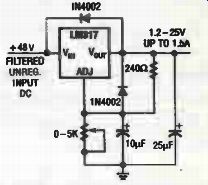
a. Surge protection
b. Protect LM317 from reverse voltage
c. Current limiter
d. Shorted load protection
3. What are the four types of power conversion?
a
4. What type of regulator is required for high current?
a. Series regulator
b. Shunt regulation d
c. Both a and b above
d. None of the above
5. Why should you not use a 60-Hertz transformer in a 50-Hertz circuit?
a. Does not make any difference
c. Overheating
b. Lower primary winding current
d. Higher secondary voltage
6. What type of transformers can be used as pre-regulators? (Select 2 answers.)
a. Autotransformer c. Any power transformer
b. Self-saturating d. Ferro-resonant
7. What possible problems could cause this waveform? (Select 2 answers.)

a. Defective diode
b. Shorted load
c. Shorted turns in the transformer
d. Open turns in the transformer
8. What is the purpose of the resistors in the diagram below?
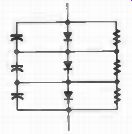
a. Prevent over-heating of the diodes
b. Shunt RF
c. Assume reverse current across each diode is the same
d. Assure reverse voltage across each diode is the same
f. Not discussed in text
9. What is the purpose of the resistors in the diagram below? (Select 2 answers.)

a. Bleed resistors
b. Current limiting
c. Prevent current hogging
d. All of the above
10. What is the purpose of the surge-limiting resistor in the diagram below? (Select 2 answers.)
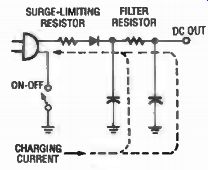
a. To protect the first capacitor
b. To protect the load
c. To protect the diode
d. To limit current during startup
11. Why do you connect the power amplifiers before the filter resistor in the diagram below? (Select 2 answers.)
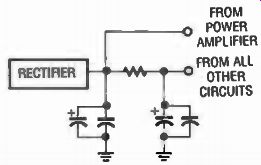
a. Power amplifiers are not voltage sensitive
b. No particular reason
c. Power amps draw high current
d. Cost is less
12. What does ESR measure?
a. Internal resistance
b. Equivalent Series Resonance
c. Parallel leakage resistance and the series resistance
d. Equal Source Resistance
13. What are some of the advantages of a switching regulator over an analog regulator? (Select the incorrect answer only!)
a. Efficiency
b. Easier troubleshooting
c. Smaller components
d. Easier to filter
14. What type of power conversion supply uses an oscillator? (Select 2 answers.)
a. AC to AC
b. AC to DC C. DC to AC
d. DC to DC
15. What circuits have to be in a closed-loop regulator?
a. Control component
b. Sense
c. Voltage comparator
d. Series-pass regulator
e. All of the above
16. What type of regulators are shown in the diagrams below?
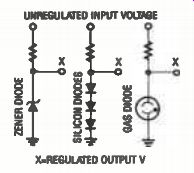
a. Open and closed loop
b. Closed loop
c. Open Loop
d. None of the above
17. What additional circuits are needed for a switching regulator over an analog regulator?
a. Startup, oscillator, comparison amplifier c. Startup, oscillator, duty cycle
b. Startup, oscillator, sense d. All of the above
18. Which of the following are pulse supplies? (Select 2 answers.)
a. Analog voltage regulator c. Scan derived
b. Chopper d. Closed-loop regulation 19. What is the purpose of the "crowbar" circuit?
a. Protection
b. Increase voltage to the load
c. Increase current to the load
d. Decrease voltage to the load
20. What is the best tip to troubleshoot a closed-loop regulator? (Refer to the diagram below.)
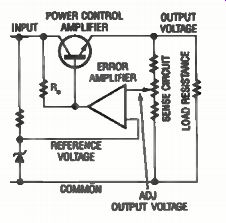
a. Remove the power control amplifier
b. Open or defeat the loop
c. Remove the load
d. All of the above
Answers:
1. Right test equipment, knowledge of how a power supply works, logical approach to troubleshooting, knowledge of a few tricks of the trade, the right tools and training for replacing faulty components and experience-not necessarily in the order given; 2. b, 3. AC to AC, AC to DC, DC to AC and DC to DC-not necessarily in the order given; 4. b; 5. c; 6 b and d; 7. a and c; 8. d; 9. c; 10. c and d; 11. a and c; 12. C; 13. b is the incorrect answer; 14. c and d; 15. e; 16. c; 17. c; 18. b and c; 19 a; 20. b.
The International Society of Electronics Technicians is located at 2708 West Berry Street, Fort Worth, Texas 76109-2356. (Telephone: 817-921-9101, FAX 817-921-3741) Write for information on becoming a Certified Electronics Technicians or upgrading your current CET status.